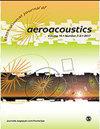Flow-noise characteristics of turbocharger compressors with rotational balance cuttings
IF 1.2
4区 工程技术
Q3 ACOUSTICS
引用次数: 1
Abstract
To correct the balance of the rotating assembly of a turbocharger, some parts of the compressor wheel are removed by cutting. A numerical investigation of the turbulent flows and flow noises produced by compressor wheels modified with such cutting parts was performed by a turbulence model and detached-eddy simulations. For the 6-cutting case, 0, 2, 4, and 6 circular cuttings and two additional—rectangular and triangular—shapes were used. To investigate the effects of the balance cuttings in a compressor wheel, the evaluation process using computational fluid dynamics was tried. It was found that the fluid forces due to the various wheel shapes have the potential to restore the eccentricity by approximately 50%. Severe variations of velocity, pressure, and turbulent kinetic energy in the interspace between the wheel and volute were observed. In particular, the wavelike patterns of pressure and turbulent kinetic energy were intensified for the modified wheels. The turbulent kinetic energy of the 6-cutting case had a dominant frequency at approximately 3000 Hz. The spectrum of the sound-pressure level of the modified compressor wheels exhibited the features of buzz-saw noise. The flow fields suggested that this feature of the sound pressure is related to the tip-clearance flow affected by the balance cuttings. In addition, the acoustic pressure and flow characteristics of the different types of modified compressor wheels were discussed and the resulting acoustic power was evaluated.带有旋转平衡切屑的涡轮增压器压缩机的流动噪声特性
为了校正涡轮增压器旋转总成的平衡,压缩机叶轮的某些零件通过切割拆下。通过湍流模型和分离涡模拟,对用这种切割件改装的压缩机叶轮产生的湍流和流动噪声进行了数值研究。对于6个切口的情况,使用了0、2、4和6个圆形切口以及另外两个矩形和三角形。为了研究压缩机叶轮中平衡切屑的影响,尝试了使用计算流体动力学的评估过程。研究发现,由各种车轮形状引起的流体力有可能使偏心率恢复约50%。在叶轮和蜗壳之间的空隙中观察到速度、压力和湍流动能的严重变化。特别是,改进后的车轮强化了压力和湍流动能的波状模式。6切割情况下的湍流动能具有大约3000Hz的主频率。改进后的压缩机叶轮的声压级频谱表现出嗡嗡声的特征。流场表明,声压的这种特征与平衡岩屑影响的叶尖间隙流量有关。此外,还讨论了不同类型的改进型压缩机叶轮的声压和流量特性,并对由此产生的声功率进行了评估。
本文章由计算机程序翻译,如有差异,请以英文原文为准。
求助全文
约1分钟内获得全文
求助全文
来源期刊

International Journal of Aeroacoustics
ACOUSTICS-ENGINEERING, AEROSPACE
CiteScore
2.10
自引率
10.00%
发文量
38
审稿时长
>12 weeks
期刊介绍:
International Journal of Aeroacoustics is a peer-reviewed journal publishing developments in all areas of fundamental and applied aeroacoustics. Fundamental topics include advances in understanding aeroacoustics phenomena; applied topics include all aspects of civil and military aircraft, automobile and high speed train aeroacoustics, and the impact of acoustics on structures. As well as original contributions, state of the art reviews and surveys will be published.
Subtopics include, among others, jet mixing noise; screech tones; broadband shock associated noise and methods for suppression; the near-ground acoustic environment of Short Take-Off and Vertical Landing (STOVL) aircraft; weapons bay aeroacoustics, cavity acoustics, closed-loop feedback control of aeroacoustic phenomena; computational aeroacoustics including high fidelity numerical simulations, and analytical acoustics.
 求助内容:
求助内容: 应助结果提醒方式:
应助结果提醒方式:


